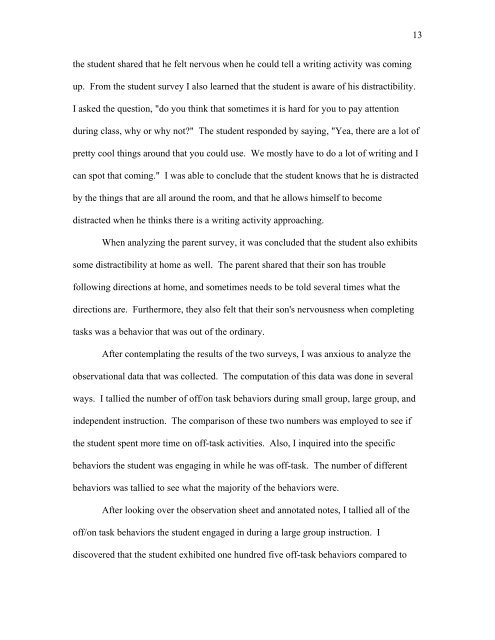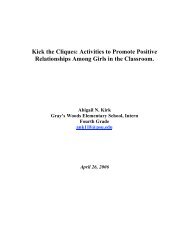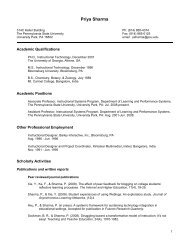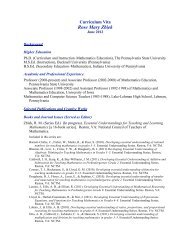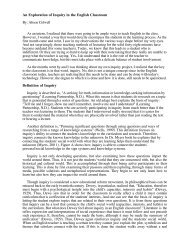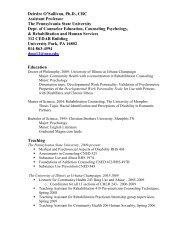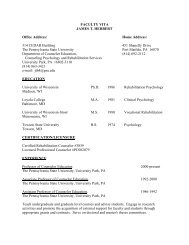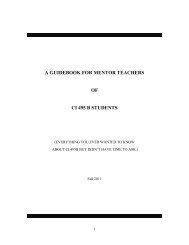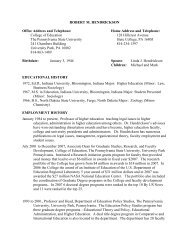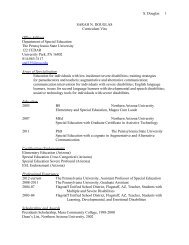Lets Focus! - the Penn State College of Education
Lets Focus! - the Penn State College of Education
Lets Focus! - the Penn State College of Education
Create successful ePaper yourself
Turn your PDF publications into a flip-book with our unique Google optimized e-Paper software.
<strong>the</strong> student shared that he felt nervous when he could tell a writing activity was coming<br />
up. From <strong>the</strong> student survey I also learned that <strong>the</strong> student is aware <strong>of</strong> his distractibility.<br />
I asked <strong>the</strong> question, "do you think that sometimes it is hard for you to pay attention<br />
during class, why or why not?" The student responded by saying, "Yea, <strong>the</strong>re are a lot <strong>of</strong><br />
pretty cool things around that you could use. We mostly have to do a lot <strong>of</strong> writing and I<br />
can spot that coming." I was able to conclude that <strong>the</strong> student knows that he is distracted<br />
by <strong>the</strong> things that are all around <strong>the</strong> room, and that he allows himself to become<br />
distracted when he thinks <strong>the</strong>re is a writing activity approaching.<br />
When analyzing <strong>the</strong> parent survey, it was concluded that <strong>the</strong> student also exhibits<br />
some distractibility at home as well. The parent shared that <strong>the</strong>ir son has trouble<br />
following directions at home, and sometimes needs to be told several times what <strong>the</strong><br />
directions are. Fur<strong>the</strong>rmore, <strong>the</strong>y also felt that <strong>the</strong>ir son's nervousness when completing<br />
tasks was a behavior that was out <strong>of</strong> <strong>the</strong> ordinary.<br />
After contemplating <strong>the</strong> results <strong>of</strong> <strong>the</strong> two surveys, I was anxious to analyze <strong>the</strong><br />
observational data that was collected. The computation <strong>of</strong> this data was done in several<br />
ways. I tallied <strong>the</strong> number <strong>of</strong> <strong>of</strong>f/on task behaviors during small group, large group, and<br />
independent instruction. The comparison <strong>of</strong> <strong>the</strong>se two numbers was employed to see if<br />
<strong>the</strong> student spent more time on <strong>of</strong>f-task activities. Also, I inquired into <strong>the</strong> specific<br />
behaviors <strong>the</strong> student was engaging in while he was <strong>of</strong>f-task. The number <strong>of</strong> different<br />
behaviors was tallied to see what <strong>the</strong> majority <strong>of</strong> <strong>the</strong> behaviors were.<br />
After looking over <strong>the</strong> observation sheet and annotated notes, I tallied all <strong>of</strong> <strong>the</strong><br />
<strong>of</strong>f/on task behaviors <strong>the</strong> student engaged in during a large group instruction. I<br />
discovered that <strong>the</strong> student exhibited one hundred five <strong>of</strong>f-task behaviors compared to<br />
13


